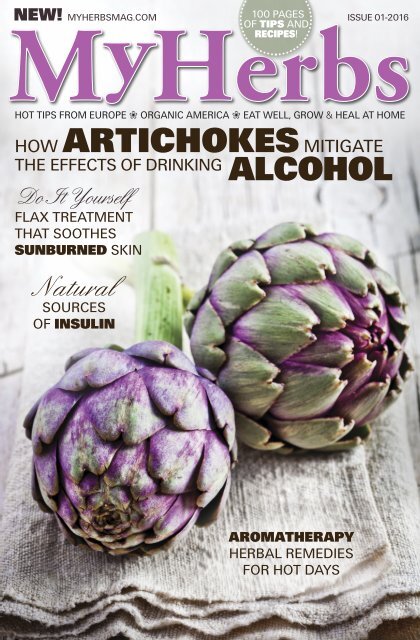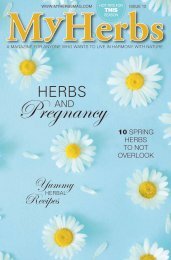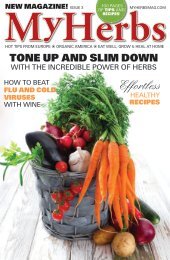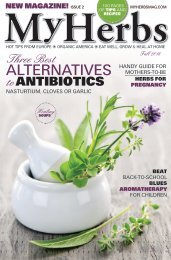MY HERBS #1
Find out more on MYHERBS-STORE.COM. My Herbs is a special quarterly publication for anyone who is interested in alternative cooking, home grown herbs, and traditional or complementary medicine or healing methods, simply for everyone who wants to live in harmony with nature.
Find out more on MYHERBS-STORE.COM.
My Herbs is a special quarterly publication for anyone who is interested in alternative cooking, home grown herbs, and traditional or complementary medicine or healing methods, simply for everyone who wants to live in harmony with nature.
Create successful ePaper yourself
Turn your PDF publications into a flip-book with our unique Google optimized e-Paper software.
NEW! <strong>MY</strong><strong>HERBS</strong>MAG.COM 100 PAGES ISSUE 01-2016<br />
OF TIPS AND<br />
RECIPES!<br />
HOT TIPS FROM EUROPE ` ORGANIC AMERICA ` EAT WELL, GROW & HEAL AT HOME<br />
ARTICHOKES HOW MITIGATE<br />
THE EFFECTS OF DRINKING<br />
ALCOHOL<br />
Do ItYourself<br />
FLAX TREATMENT<br />
THAT SOOTHES<br />
SUNBURNED SKIN<br />
Natural<br />
SOURCES<br />
OF INSULIN<br />
AROMATHERAPY<br />
HERBAL REMEDIES<br />
FOR HOT DAYS
PRINTED CONSIDERATELY,<br />
WITH NATURE IN MIND<br />
FSC ® CERTIFIED
ISSUE 01<br />
JULY, AUGUST, SEPTEMBER<br />
To subscribe to My Herbs, please visit our website:<br />
MyHerbsMag.com
2 <strong>MY</strong> <strong>HERBS</strong> MAGAZINE
Dear readers,<br />
Welcome to My Herbs, the one and only magazine for your natural health<br />
and happiness. In this first issue, you will find great advice and tips from the<br />
wonderful world of herbs to help you make the most of the summer season.<br />
My Herbs is published quarterly and is available on shelves in 23 different<br />
countries. Because we reach an international audience, we prepared a simple<br />
unit conversion chart for the recipes in My Herbs.<br />
We hope you enjoy our introductory issue and thank you for your readership.<br />
Wishing you the best during these abundant summer months,<br />
Kelsey Quinn and the rest of the My Herbs editorial staff.<br />
SUBSCRIBE TO My Herbs AT<br />
<strong>MY</strong><strong>HERBS</strong>MAG.COM<br />
UNIT CONVERSION CHART<br />
WEIGHT<br />
1 Pound lb. 454 Grams / 0.5 Kilograms<br />
1 Ounce oz. 28 Grams<br />
1 Dram (Pinch) dr. 2 Grams<br />
1 Grain gr. 65 Milligrams<br />
VOLUME<br />
1 Quart qt. 1000 Milliliters / 1 Liter<br />
1 Pint pt. 0.5 Liter / 2 Cups<br />
1 Cup 0.25 Liter<br />
1 Fluid ounce fl oz. 30 Milliliters / 0.33 Liter<br />
1 Tablespoon tblsp. 15 Milliliters<br />
1/2 Tablespoon 7.5 Milliliters<br />
1 Teaspoon tsp. 5 Mililliters<br />
1/2 Teaspoon 2.5 Milliliters<br />
<strong>MY</strong><strong>HERBS</strong>MAG.COM<br />
3
C O N T E N T S<br />
8 Herbal Ecogarden<br />
A well-organized herbal garden is the<br />
dream of every gardener and herbalist.<br />
Choose the types of herbs you like best,<br />
and arrange the garden for maximum<br />
effect and co-existence. Also, learn<br />
which herbs to choose according to<br />
their qualities.<br />
15 Grapevines<br />
Fit into your swimsuit and cleanse your<br />
body! Grapevines are a perfect means<br />
for detoxifying the body, whether we<br />
are talking about the leaves or the fruit.<br />
Both have salutary effects on our figure.<br />
20 The Thyroid<br />
We are often affected by decreased or<br />
increased functioning of this gland,<br />
connected with autoimmunity inflammations.<br />
We discuss these two problems<br />
in a two-part article, advising you<br />
how to use natural remedies to return<br />
to the status of full health. Part one on<br />
diminished thyroid gland function is<br />
found here.<br />
28 Artichokes<br />
This tidbit of kings also has healing<br />
properties.<br />
32 Herbal Advice<br />
My Herbs advice on raw food.<br />
34 Summer Aromatherapy<br />
Essential oils can help with swelling,<br />
sunburn, bee stings and diarrhea. These<br />
recipes specific for summer will certainly<br />
be a great aid.<br />
38 Cannabis – Universal Medicine<br />
The first part of our new series about<br />
the most controversial herb of our<br />
time.<br />
42 Yarrow<br />
An herb for fever, digestive problems<br />
and women’s health issues.<br />
4 <strong>MY</strong> <strong>HERBS</strong> MAGAZINE
44 My Herbs Calendar<br />
July is a month connected especially<br />
with blood circulation. Learn how to<br />
improve your blood circulation and<br />
which herbs are suitable for its<br />
strengthening.<br />
46 Deng Shen<br />
Deng shen is an herb certainly worthy<br />
of note. One does not hear so much<br />
about it, and that’s a shame, for herbalists<br />
call it the “poor man’s ginseng.” It’s<br />
an easily available herb with strong, invigorating<br />
effects on the body. It fights<br />
fatigue, increases the libido and the resulting<br />
effects, helps with high blood<br />
pressure, and can bring the body back<br />
into shape after surgery.<br />
50 Oats<br />
Oats are high in roughage, and we<br />
would do well not to underestimate<br />
this grain.<br />
54 Vitamins A–Z<br />
We start with vitamin A.<br />
56 Proteins<br />
How do they work in our body and<br />
how many do we really need? Which<br />
are the best sources of proteins for us?<br />
60 The Darker Side of Sunblock<br />
We wear it to protect ourselves. But<br />
could what we use to protect ourselves<br />
actually contain chemicals that cause us<br />
harm?<br />
62 Raw Food Recipes<br />
In this issue, we invite you to a rawfoods<br />
feast.<br />
70 Botanical Chemistry<br />
The most often-found substances in<br />
commonly used garden and natural<br />
products. Learn which phytochemicals<br />
are found in tomatoes, grapes, green<br />
tea, walnuts, and other fruits and vegetables<br />
and how to make the most of<br />
them.<br />
72 Wild Plants<br />
Edible fruits, served up by nature.<br />
76 For Women<br />
Alternative treatments<br />
for incontinence.<br />
78 For Men<br />
Take care of your large intestine.<br />
80 Hives Affect More People<br />
Every fifth person on this planet has<br />
suffered at least once from some type of<br />
hives.<br />
82 Diabetes<br />
One can defend oneself against it, and<br />
even fight it. We also add a list of natural<br />
sugars.<br />
84 Natural Repellents<br />
Not only against mosquitoes, but also<br />
against aphids and moths.<br />
88 Summer Heat Waves<br />
Overcome problems with overheating.<br />
90 Tea<br />
We reveal its secrets.<br />
<strong>MY</strong><strong>HERBS</strong>MAG.COM 5
Subscription<br />
On-line: $14.98<br />
Printed: $29.98<br />
On-line + Printed:<br />
$29.98<br />
Subscribe Now<br />
Limited Time Offer
New Magazine Out<br />
My Herbs<br />
Inside Every Issue:<br />
– Tasty (and easy!) whole food recipes<br />
– Get to know herbs – and what they can do for you!<br />
– DIY projects to enhance your beauty and health<br />
Don’t<br />
Miss It<br />
Sign up now & get the new My Herbs issue<br />
delivered directly to your door<br />
(4 printed issues / year).<br />
My Herbs - New issue every 3 months.<br />
New issue every 3 months<br />
with information specific<br />
to the new season.<br />
Please visit our website and fill in the form.<br />
MyHerbsMag.com<br />
E-mail: magazine@MyHerbsMag.com<br />
Phone: +1 (415) 231-3767<br />
Address:<br />
ACV PUBLISHING LLC<br />
5348 Vegas Dr., <strong>#1</strong>423<br />
Las Vegas, Nevada 89108, USA
Herbs in<br />
Environmentally<br />
Friendly<br />
Gardens<br />
Perennial plants, or simply perennials, are plants that can<br />
grow in the garden for a number of years. Some species<br />
from warmer regions are only able to survive the winter<br />
by being brought inside in October and kept there until<br />
after the last frost in late April or early May.<br />
<strong>MY</strong><strong>HERBS</strong>MAG.COM<br />
9
LLet us leave out the wide variety of<br />
one-year and two-year wonders,<br />
like plants that bloom for a first or second<br />
year, shed seeds and die. They are<br />
good to grow in special flower beds,<br />
usually together with vegetables (common<br />
marigolds, French marigolds,<br />
snapdragons, Nigella arvensis). But I<br />
will take you into the realm of perennials,<br />
which, with minimum work, create<br />
an environmentally friendly herb garden.<br />
MAKING THE MOST<br />
OF PERENNIALS<br />
The most popular reason for creating<br />
perennial beds is merely for a pretty<br />
garden. Why not? In such a garden,<br />
pretty perennials do not have to be the<br />
Herbal garden<br />
only choice, for there may be edible<br />
and medicinal plants, or pollen rich<br />
ones, or even species for dyeing.<br />
As for aromatic herbs, they are usually<br />
clustered together, ideally in a sunny<br />
place near the entrance, in order to be<br />
easily reached from the kitchen.<br />
Ground-covering species of perennials<br />
are suited under fruit trees, as well as<br />
under the forest trees and bushes. They<br />
simply grow over the ground, needing<br />
no pruning, especially when you choose<br />
the right, ones and cover them with<br />
a protective layer of organic material<br />
during the first years. This is to win the<br />
battle over weeds and grass in order to<br />
create a lasting compact cover.<br />
Bunchy and trailing perennials can<br />
also line paths, pavements, patios or<br />
lawn edges. So you can sell the trimmer,<br />
as an ordinary lawn mower or scythe<br />
is able to cut up to the edge of the<br />
perennials, and there is no unwanted<br />
grass in less accessible edges. There are<br />
also very substantial and large perennials,<br />
which can be combined with<br />
shrubs, or used separately.<br />
And don’t forget water elements for<br />
perennials like to grow on the edge of<br />
water, whether in the shallows or the<br />
depths. They even help clean the water.<br />
In order to grow, they collect nutrients,<br />
thus starving algae to death. The main<br />
advantage of perennials is that they are<br />
easy to find a home for. If your garden<br />
is not big enough for trees, you can still<br />
have hundreds of species of perennials<br />
in a relatively small piece of land instead.<br />
PROPER HABITAT<br />
In all cases, there are two basic selection<br />
factors – putting the plant in a<br />
place where you have chosen to grow it<br />
(its area requirements) and your preferences<br />
about its appearance and function.<br />
It is not a good idea to buy a<br />
plant about which we know nothing,<br />
and put it in the first aesthetically pleasing<br />
place. With luck it may survive,<br />
but it will more likely suffer and die. In<br />
stores, one can find ornamental and relatively<br />
unusual species of plants grown<br />
in peat compost substrates certainly<br />
with the mind to lure customers back<br />
with their credit cards for replacements.<br />
If you are looking for durable, proven<br />
and honestly grown specimens, you<br />
first need to find out exactly what you<br />
want, and then look for specialized growers.<br />
Thanks to the Internet it<br />
shouldn’t be hard.<br />
With all plants, and this also applies to<br />
10 <strong>MY</strong> <strong>HERBS</strong> MAGAZINE
trees, we deal with them according to<br />
their preference for sun, shade or partly<br />
shady, drought, moisture or a mixture<br />
of both and what pH of soil is needed<br />
– if acidic, alkaline or neutral. Acidic<br />
species are commonly sold (astilboides,<br />
heathers, azaleas, rhododendrons, blueberries),<br />
but acidic soil in gardens is<br />
A melange of herbs<br />
pretty rare. This is due to increased<br />
sales of peat and acidifying fertilizers<br />
needed to grow them, with their effect<br />
disappearing in a few years because the<br />
soil is basically self-healing and returns<br />
to its natural neutral status. So again,<br />
this is just a question of making<br />
money.<br />
Do not use peat as, due to its extraction,<br />
it is destroying the remaining beautiful<br />
places left in the world and is<br />
transported over half the continent. If<br />
your garden does not have a coniferous<br />
wooded area which acidifies the soil beneath,<br />
acidic plant species should be<br />
avoided, as there are plenty of alternatives<br />
growing in ordinary garden soil,<br />
which most often read around pH<br />
6.5–7 (about neutral).<br />
SELECTION BY QUALITY<br />
Every plant is beautiful in its own<br />
way, so I would prefer not to discuss<br />
beauty and colour of the flowers or leaves.<br />
The elephant is no less beautiful<br />
than the tiger just because it has fewer<br />
stripes. Some of us prefer elephants,<br />
and others prefer tigers. To each their<br />
Mint<br />
own. Up until now, the underestimated<br />
qualities of perennials include being<br />
edible, as well as other important functions<br />
they play in the garden ecosystem.<br />
In terms of being edible, we are acquainted<br />
mainly with medicinal herbs<br />
for teas and the occasional leaf accompanying<br />
a salad, or as garnish. We can<br />
go much further though – there are perennials<br />
with edible flowers (daylilies,<br />
hosta or plantain lily, mallow), edible<br />
roots or bulbs (Jerusalem artichokes,<br />
water-parsnip, horseradish, hardy onions<br />
and garlic, groundnut, woundwort<br />
bulbs), with leaves of spinach (comfrey,<br />
nettle, sanguisorba, knotweed), with leaves<br />
for seasoning salads (cicely, chivegarlic,<br />
wild garlic, sanguisorba, garden<br />
sorrel), with edible shoots (asparagus,<br />
buck’s beard, bamboo) or with edible<br />
fruits and seeds (strawberry, gooseberry,<br />
mallow).<br />
From edible perennials we could<br />
make year-round sustainability just by<br />
knowing all the varieties and knowhow.<br />
The plants may be preserved also<br />
during the winter. In the stomach remains<br />
of one of our ancient ancestors<br />
who had drowned in the swamps, scientists<br />
confirm they had found over<br />
thirty different herbs which served as<br />
breakfast on that fateful day. You know<br />
how healthy he could have been? If he<br />
had only watched where he was stepping!<br />
<strong>MY</strong><strong>HERBS</strong>MAG.COM<br />
11
Our current food industry is relatively<br />
lifeless. More edible perennials would<br />
certainly liven up our plate. Creative<br />
people take a particular interest in perennials<br />
for providing various materials<br />
and active substances, along with pharmaceuticals,<br />
dyes, fragrances, oils, fertilizers,<br />
animal feed or biomass. High<br />
growing species also provide a visual<br />
barrier and protection, such as shelter<br />
for animals, and hollow stems – which<br />
in winter house environmentally beneficial<br />
insects. They also provide seeds<br />
for feeding birds. Any surplus material<br />
may be used for compost or mulch.<br />
GUILD – FUNCTIONAL<br />
COMMUNITY<br />
In permaculture the word guild is<br />
used for a community body of plants<br />
mutually dedicated to supporting each<br />
other – perennials and wood plants.<br />
This community of plants not only<br />
helps individually, but comprehensively<br />
assists the garden as a whole.<br />
As an example, let us look at the plant<br />
surroundings of a fruit tree. Plants in<br />
this community build profitable relationships<br />
in many ways: they attract beneficial<br />
insects for pollination and<br />
natural pest control, improve soil fertility,<br />
reduce root spreading competition,<br />
retain moisture, balance the amount of<br />
mould and cooperate with underground<br />
fungi.<br />
Thanks to substances from the so-called<br />
mycorrhizal fungi, the plants are<br />
able to treat their own ailments, thus<br />
receiving more water and nutrients.<br />
This results in better growth and production.<br />
These symbiotic fungi can<br />
also inoculate the plants from special<br />
ingredients in the soil. The result of<br />
this guild, connected both under and<br />
above ground with its vast and largely<br />
unknown number of relationships, is a<br />
healthier tree and ecological balance.<br />
This removes a lot of work from the<br />
gardener’s shoulders, thus maintaining<br />
a sustainable, ecological cycle.<br />
By combining more plant communities<br />
together, we gain greater stability and<br />
benefits than those provided by each<br />
plant alone.<br />
The quantity of plants depends on<br />
the size of the tree and the entire group<br />
– obviously the larger tree, the smaller<br />
the community and vice-versa. Every<br />
garden has different conditions, and<br />
planting around and under a tree depends<br />
on its size, density of the tree top<br />
and climatic conditions.<br />
All gardeners have to figure out for<br />
themselves what their guild needs.<br />
There is no exact manual, just some<br />
guidelines and ideas that can help us<br />
achieve the desired results as soon as<br />
possible and in the best form. We can<br />
experiment, for it is harmless; perennials<br />
which are planted badly can be<br />
easily replanted, but it is important to<br />
keep an eye on everything. In order to<br />
catch as much sun as possible, we sow<br />
low from the south side and build the<br />
terraced garden higher towards the<br />
north. This also applies to planting in<br />
forests with edible species and small<br />
patches in the middle of the lawn.<br />
Plants for a Working<br />
GUILD<br />
Plants for mulching – covering the<br />
soil surface with a carpeting layer or<br />
large leaves, holding moisture and keeping<br />
weeds at bay (hosta, geranium,<br />
waldsteinia – aka barren strawberries).<br />
Plants releasing nitrogen in soil –<br />
working together with root bacteria,<br />
feeding the surrounding perennials and<br />
wooden plants (lupines, peas, clover).<br />
12 <strong>MY</strong> <strong>HERBS</strong> MAGAZINE
Plants dynamically accumulating nutrients<br />
– for example, long roots deliver<br />
vital minerals from the depths, and<br />
leaves supply minerals to us and the<br />
land (comfrey, horseradish, dandelion).<br />
Plants attracting and repelling insects<br />
– a confusion of fragrance is created,<br />
pests oriented by smell don’t<br />
multiply on any part of the plant as<br />
they flit around in confusion and are<br />
thus, eaten by predators (sage, lavender,<br />
catnip).<br />
Edible plants – fit in all categories<br />
dealt with here – with a variety of<br />
edible parts both above and below<br />
ground. Hundreds of edible<br />
perennials exist, but be<br />
warned: do not eat what<br />
you do not exactly<br />
know!<br />
You can grow different herbs in one pot<br />
<strong>MY</strong><strong>HERBS</strong>MAG.COM<br />
13
Plants with multiple purposes – the<br />
more purposes a plant has (whilst suiting<br />
the chosen habitat), the more beneficial<br />
it is for the guild.<br />
HERB SPIRAL<br />
The herb spiral or simple mound in<br />
permaculture gardens is a very common<br />
phenomenon. It was invented for<br />
one simple reason – herbs need to be at<br />
our fingertips, preferably at the entrance<br />
to the home or on the terrace.<br />
The closer they are, the more we will<br />
use them.<br />
However, there is a plethora of herb<br />
species with different habitat requirements.<br />
The spiral or simple earth<br />
mound nevertheless meets these requirements<br />
on a relatively small piece of<br />
land.<br />
The top is dry, sunny, permeable to<br />
moisture and perfect for our hydrophilic<br />
and Mediterranean species (thyme,<br />
lavender, oregano, yarrow).<br />
The middle and lower area down to<br />
the foot is more fertile and hosts most<br />
of the other herbs (lemon balm, sage,<br />
skullcap, hyssop, wormwood, coneflower,<br />
common agrimony aka sticklewort).<br />
The northern, eastern and<br />
western heels of the mound are in the<br />
shade and host other edible species<br />
(costmary, cicely, mint).<br />
Whether you prefer to plant herbs in<br />
buried containers or somewhere else,<br />
they will grow strongly. And in the case<br />
of our environment encompassing medicinal<br />
plants growing in water or moisture,<br />
we can bury an old tin tub right<br />
in the bank, seal it well, fill with water<br />
and put gravel on the bottom.<br />
We can also grow herbs sunk into<br />
pots filled with gravel, ideally edible<br />
aquatic plants (sweet flag aka calamus,<br />
broadleaf arrowhead, broadleaf cattail,<br />
caltrop, buckbean, watercress or butomus).<br />
Great Basil<br />
We need to know at what depth the<br />
various herbs like to grow.<br />
It is also possible to grow in an old<br />
tub. First, put a wooden board in the<br />
tub at an angle, in order for small<br />
members of the animal kingdom to<br />
climb out in case they fall inside. Various<br />
technical planting details of growing<br />
in tubes can be found on the<br />
Internet.<br />
FINAL WORD<br />
We live surrounded by many new<br />
things, such as technical appliances and<br />
equipment, yet this world is much poorer<br />
than it once was. Civilization has<br />
given us a lot of both useful and useless<br />
technocratic gifts, and endless space on<br />
the web, but has subsequently robbed<br />
us of nature.<br />
And it is nature which keeps the<br />
human body and soul in prime condition.<br />
Dig up a little piece of turf,<br />
empty a bag of bought compost into<br />
the hole, plant between 5–10 different<br />
varieties of (not so run of the mill)<br />
edible perennials, and water them a few<br />
times. This is manageable for anyone,<br />
and the benefits are remarkable.<br />
Between the plants, mulch cut grass,<br />
leaves, or straw (bark is not really suitable<br />
for herbs), and you will save further<br />
watering and weeding. The next<br />
year, you may realise that last season’s<br />
afternoon was the most valuable investment<br />
of time you had made.<br />
14 <strong>MY</strong> <strong>HERBS</strong> MAGAZINE
Yarrow Face Tonic<br />
The production of a skin tonic is very simple;<br />
all one needs is water, yarrow, glycerine and (optionally)<br />
panthenol. First, all the containers and<br />
stirrers must be disinfected with a high alcoholbased<br />
disinfectant. To start the process, make<br />
a strong tea from 3 teaspoons of dried yarrow and<br />
120 ml (half a cup) of mineral or distilled water.<br />
After the tea cools down, filter it, and – with the<br />
remaining 92 ml (one-third cup) of prepared tea<br />
– add 5 ml (1 teaspoon) of glycerol and 3 ml (half<br />
a teaspoon) of panthenol (you can also add 10<br />
drops of yarrow essential oil). For a cleansing<br />
tonic, then add 2 ml (half a teaspoon) of soap<br />
base instead of the tea content. This tonic is suitable<br />
for problematic or oily skin. When stored in<br />
the refrigerator it doesn’t need any preservatives.<br />
Try<br />
Suitable for<br />
problematic<br />
or oily skin.<br />
See page 42<br />
<strong>MY</strong><strong>HERBS</strong>MAG.COM 15
Common<br />
Grape Vine<br />
(Vitis vinifera)<br />
16 <strong>MY</strong> <strong>HERBS</strong> MAGAZINE












